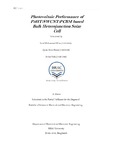| dc.contributor.advisor | Mominuzzaman, Dr. Sharif Mohammad | |
| dc.contributor.author | Khan, Saad Mohammed | |
| dc.contributor.author | Hasan, Ajnan Aron | |
| dc.contributor.author | Saha, Avizet | |
| dc.date.accessioned | 2016-01-17T16:53:07Z | |
| dc.date.available | 2016-01-17T16:53:07Z | |
| dc.date.copyright | 2015 | |
| dc.date.issued | 2015-12-19 | |
| dc.identifier.other | ID 11221024 | |
| dc.identifier.other | ID 11221058 | |
| dc.identifier.other | ID 11221042 | |
| dc.identifier.uri | http://hdl.handle.net/10361/4871 | |
| dc.description | This thesis report is submitted in partial fulfillment of the requirements for the degree of Bachelor of Science in Electrical and Electronic Engineering, 2015. | en_US |
| dc.description | Cataloged from PDF version of thesis report. | |
| dc.description | Includes bibliographical references (page 53-57). | |
| dc.description.abstract | Organic photovoltaic cells are believed to be the ideal alternative to silicon based solar cell devices due to its low cost, ease of fabrication and high mechanical flexibility. However, despite possessing such astounding properties their application in the main stream market has been limited due to its low PCE. The efficiency of bulk heterojunction solar cell is limited primarily due to the low carrier mobility of the polymer and the active layer’s incapability to absorb photon wavelengths in the NIR region. SWCNTs are known to have high carrier mobility due its ballistic property and can also absorb photon wavelengths in the NIR region. This fascinating optical and electrical property of SWCNT makes them a promising material as an additive to a Polymer: Fullerene based active layer composite. In this work we examine the influence of SWCNT on the absorption spectra and the J-V characteristics of P3HT: PCBM based bulk heterojunction solar cell. The optical simulation of the bulk heterojunction solar cell was carried out using the optical transfer matrix methodology while analytical solutions of 1D drift-diffusion equation were used to predict the J-V characteristics of the organic photovoltaic device. The optical simulation result show that the incorporation of SWCNT to the P3HT: PCBM active layer composite widens the absorbance spectrum by increasing the absorption coefficient in the UV and as well as infra-red region. The result obtained from the J-V curve show that the photovoltaic performance of the P3HT: PCBM solar cell devices depend on the concentration of SWCNT. The incorporation of the 1% SWCNT improved the Jsc by 10%. The Voc at 1wt% SWCNT remained relatively the same while the power conversion efficiency enhanced by 34%. | en_US |
| dc.description.statementofresponsibility | Saad Mohammed Khan | |
| dc.description.statementofresponsibility | Ajnan Aron Hasan | |
| dc.description.statementofresponsibility | Avizet Saha | |
| dc.format.extent | 77 pages | |
| dc.language.iso | en | en_US |
| dc.publisher | BRAC University | en_US |
| dc.rights | BRAC University thesis are protected by copyright. They may be viewed from this source for any purpose, but reproduction or distribution in any format is prohibited without written permission. | |
| dc.subject | Electrical and electronic engineering | en_US |
| dc.subject | P3HT | en_US |
| dc.subject | Organic photovoltaic cells | en_US |
| dc.subject | Solar cell | en_US |
| dc.title | Photovoltaic performance of P3HT: SWCNT: PCBM based bulk heterojunction solar cell | en_US |
| dc.type | Thesis | en_US |
| dc.contributor.department | Department of Electrical and Electronic Engineering, BRAC University | |
| dc.description.degree | B. Electrical and Electronic Engineering | |

